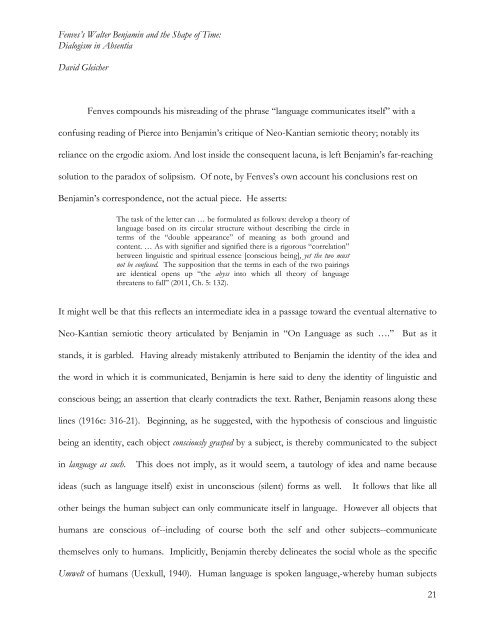Peter Fenves's Walter Benjamin and the Shape ... - Adelphi University
Peter Fenves's Walter Benjamin and the Shape ... - Adelphi University
Peter Fenves's Walter Benjamin and the Shape ... - Adelphi University
You also want an ePaper? Increase the reach of your titles
YUMPU automatically turns print PDFs into web optimized ePapers that Google loves.
Fenves’s <strong>Walter</strong> <strong>Benjamin</strong> <strong>and</strong> <strong>the</strong> <strong>Shape</strong> of Time:<br />
Dialogism in Absentia<br />
David Gleicher<br />
Fenves compounds his misreading of <strong>the</strong> phrase “language communicates itself” with a<br />
confusing reading of Pierce into <strong>Benjamin</strong>’s critique of Neo-Kantian semiotic <strong>the</strong>ory; notably its<br />
reliance on <strong>the</strong> ergodic axiom. And lost inside <strong>the</strong> consequent lacuna, is left <strong>Benjamin</strong>’s far-reaching<br />
solution to <strong>the</strong> paradox of solipsism. Of note, by Fenves’s own account his conclusions rest on<br />
<strong>Benjamin</strong>’s correspondence, not <strong>the</strong> actual piece. He asserts:<br />
The task of <strong>the</strong> letter can … be formulated as follows: develop a <strong>the</strong>ory of<br />
language based on its circular structure without describing <strong>the</strong> circle in<br />
terms of <strong>the</strong> “double appearance” of meaning as both ground <strong>and</strong><br />
content. … As with signifier <strong>and</strong> signified <strong>the</strong>re is a rigorous “correlation”<br />
between linguistic <strong>and</strong> spiritual essence [conscious being], yet <strong>the</strong> two must<br />
not be confused. The supposition that <strong>the</strong> terms in each of <strong>the</strong> two pairings<br />
are identical opens up “<strong>the</strong> abyss into which all <strong>the</strong>ory of language<br />
threatens to fall” (2011, Ch. 5: 132).<br />
It might well be that this reflects an intermediate idea in a passage toward <strong>the</strong> eventual alternative to<br />
Neo-Kantian semiotic <strong>the</strong>ory articulated by <strong>Benjamin</strong> in “On Language as such ….” But as it<br />
st<strong>and</strong>s, it is garbled. Having already mistakenly attributed to <strong>Benjamin</strong> <strong>the</strong> identity of <strong>the</strong> idea <strong>and</strong><br />
<strong>the</strong> word in which it is communicated, <strong>Benjamin</strong> is here said to deny <strong>the</strong> identity of linguistic <strong>and</strong><br />
conscious being; an assertion that clearly contradicts <strong>the</strong> text. Ra<strong>the</strong>r, <strong>Benjamin</strong> reasons along <strong>the</strong>se<br />
lines (1916c: 316-21). Beginning, as he suggested, with <strong>the</strong> hypo<strong>the</strong>sis of conscious <strong>and</strong> linguistic<br />
being an identity, each object consciously grasped by a subject, is <strong>the</strong>reby communicated to <strong>the</strong> subject<br />
in language as such. This does not imply, as it would seem, a tautology of idea <strong>and</strong> name because<br />
ideas (such as language itself) exist in unconscious (silent) forms as well. It follows that like all<br />
o<strong>the</strong>r beings <strong>the</strong> human subject can only communicate itself in language. However all objects that<br />
humans are conscious of--including of course both <strong>the</strong> self <strong>and</strong> o<strong>the</strong>r subjects--communicate<br />
<strong>the</strong>mselves only to humans. Implicitly, <strong>Benjamin</strong> <strong>the</strong>reby delineates <strong>the</strong> social whole as <strong>the</strong> specific<br />
Umwelt of humans (Uexkull, 1940). Human language is spoken language,-whereby human subjects<br />
21


